TheN iN the eNd...
In an effort to add some completion to these six-year-old blog posts, here's the speed-of-light update on what happened with the Ford 2N tractor.
I did get the tractor running and the hydraulic system functional. Rebuilding the carburetor the first time didn't help it idle very well. Neither did the second rebuild, nor the third. Eventually, I just decided to accept the fact that the tractor had a lumpy idle, and only really made power with the choke pulled out a little bit, and moved on.
The tractor store over in the valley had parted out a few of these tractors, and I purchased a used seat and fender. They apparently thought that these pieces were made of a rare and valuable metal, as the two together cost me almost one third of the tractor's original purchase price back in 1943. I also bought a fleabay muffler and exhaust pipe, opting for a stack rather than a rear exhaust.
In May of 2014, my friend Mark came down from Portland, and we spent several days on the tractor getting it into usable shape. Mark is a master at getting rusty bolts apart, he has a lot more patience at it than I do.
After a few hours of work, we had the front end loader on the tractor removed. I used my 1971 Case 580CK backhoe (purchased for $800, and no, I'm not going to blog about it [oops, I guess I just did]) to lift the rusted hulk off the Ford. The loader was a total loss, it was so crumbly and rusted that I hauled it directly to the scrap recycle yard.
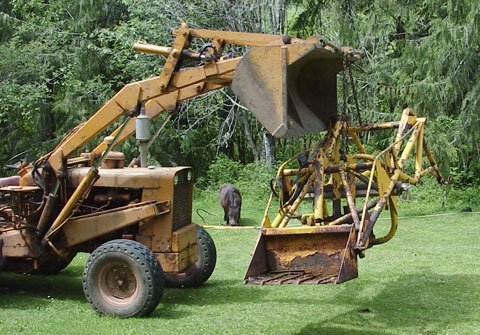
We put the Ford in the carport and spent a few more hours repairing, removing the sheet metal so that the fuel tank could be changed, putting in halfway permanent wiring and restoring the fenders and exhaust system that were removed during the loader removal.
Mark was itching to see the tractor drive, so I rigged up the fuel tank from my IH Cub Cadet garden tractor, and let him go down the hill, cautioning him that the tractor had no brakes, and that I didn't know if it had enough power to make it back up the hill.
Apparently, he wasn't too concerned and threw caution to the wind, here he is going full-tilt in third gear:
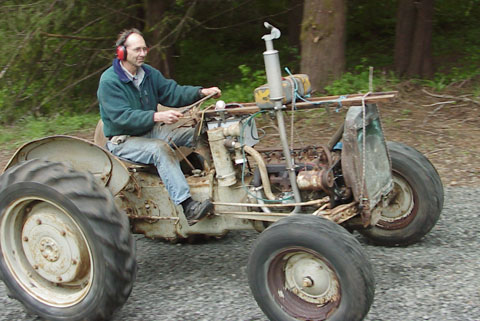
We left the sheet metal off the tractor so I could finish the wiring and order and install new radiator hoses and a thermostat.
The next weekend, Mark returned, bringing a used 60" rotary field mower that he had purchased at my request. The mower was in pretty rugged shape, and we spent the better part of two days straightening, welding, and reinforcing it. It turned out pretty well, and I made plans to purchase some replacement blades, as those on it were worn and unbalanced.
Finally, I had something worthy of using for pasture maintenance.
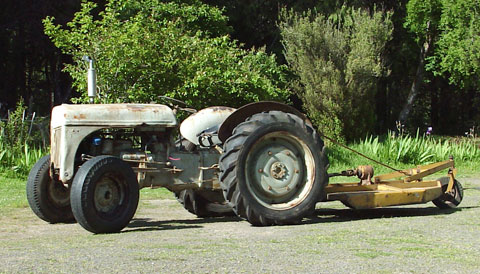
The tractor looked a lot smaller without the loader, and it was a lot easier to steer too, without all the weight up front. The front tires needed replacing, and the proper ag tires were $130 each. Because the wheels were rusted beyond use, I needed to replace them also at $80 each, this was getting expensive quickly. The front hubs on the tractor required specific wheels, but this bolt pattern went out of use decades ago, so the wheels that are available are $$$. Fleabay to the rescue again, I purchased some front hubs from a Ford 8N, which use a bolt pattern that has become common for ag equipment. Mark picked up a couple of used wheels on the last trip down, and the two of us went to the wrecking yard in town to scratch around in the used tire pile. I found a pair of like-new bias ply 7.00-15 truck tires that the yard operator let me have for free. Scored again!
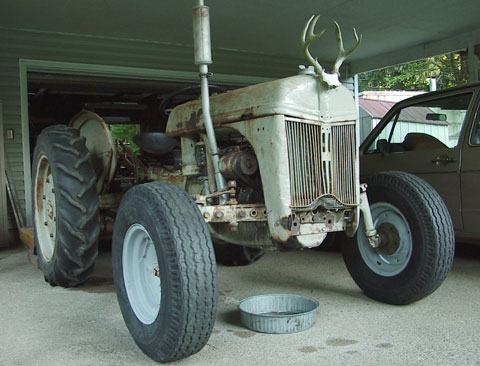
The first mow of the Spring season was much faster than I had been used to. My garden tractor took about 20 hours of mowing over the course of several days to do the whole field. The Ford did the same job better in about two hours. Because the wheels and tires are bigger, I got bounced and jostled around a whole lot less, and didn't feel like I had been beaten when it was over. Fuel economy was lots better too!
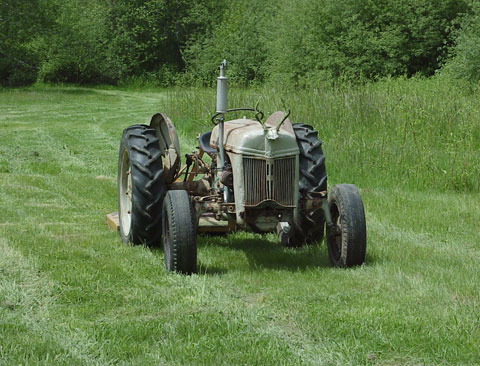
Since getting the tractor operational, I've had to replace the water pump, and the rear seal for the PTO leaked and needed to be serviced, but overall, it is much less work than the garden tractor, and much less expensive than the couple of times I had contracted the work out to someone else. That was $250 per mow. Now I can mow as often as I like for the price of two gallons of fuel per hour.
Because the legend of early tractors is that they are farmer killers, I use this tractor exclusively for mowing, never hauling with the drawbar, etc. It has exactly zero safety equipment, no ROPS, etc. It still has very little in the way of brakes (the right-hand brake works - sort of - and is handy for helping pull the tractor to the right during tight turns while mowing). The PTO shaft to the mower gearbox does have a slip tube on it for safety, but I still treat that PTO shaft as if it were a coiled rattlesnake when it is moving even a little bit.
Eventually, I'll replace this machine with something more modern, but for now, it gets the job done.
Original material ©1996-2025 Mr. Sharkey | All rights reserved
